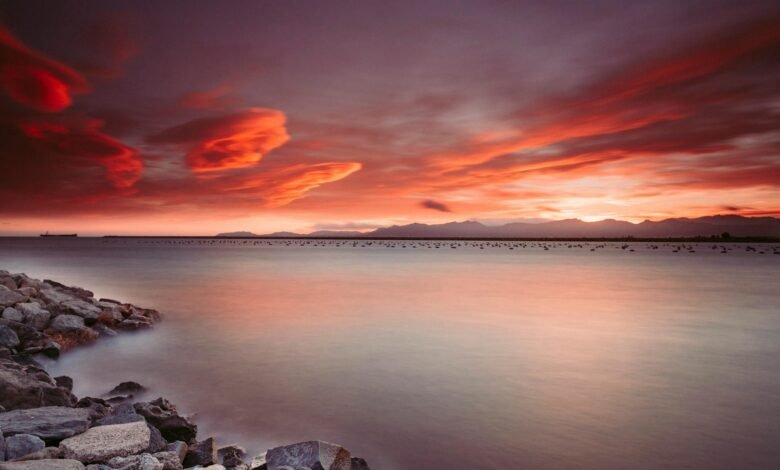Mediterranean Sardinia: A Complete Guide to the Island of Sun, Sea, and Soul

Sardinia is one of those places that captures your heart from the moment you arrive. Floating gracefully in the middle of the Mediterranean Sea, just west of mainland Italy, it’s a world of turquoise waters, sun-bleached cliffs, ancient traditions, and unforgettable food.
The island feels both Italian and completely unique. It has its own rhythm, its own language, and a charm that grows on you slowly. I remember stepping off the ferry in Olbia for the first time — the scent of sea salt in the air, the warmth of the sun, and that indescribable feeling of peace that only the Mediterranean can give.
Sardinia isn’t just a beach destination. It’s a living story — one filled with history, culture, and natural beauty that goes far beyond what any travel brochure could capture.
2. A Brief History of Sardinia
Sardinia’s history goes back thousands of years. Long before the Romans or Phoenicians arrived, the island was home to the Nuragic civilization, one of Europe’s oldest. Their mysterious stone towers, called nuraghe, still dot the countryside — silent witnesses of an ancient world.
Over the centuries, Sardinia has been influenced by many cultures — the Carthaginians, the Romans, the Spanish, and later the Italians. Each left a mark that shaped its language, architecture, and way of life. Even today, many Sardinians speak Sardu, a language distinct from Italian, and still follow local customs that have survived for generations.
When you wander through a small Sardinian village, you’ll notice how history lives side by side with modern life. The old churches, traditional festivals, and simple stone houses tell stories of pride and resilience — of a people deeply connected to their land.
3. The Geography and Natural Beauty of the Island
Sardinia is the second-largest island in the Mediterranean, and it offers an incredible variety of landscapes. In one day, you can go from the sandy beaches of Costa Smeralda to rugged mountain ranges like Gennargentu, where shepherds still live much as they did centuries ago.
The coastline stretches for almost 2,000 kilometers — filled with cliffs, bays, and some of the most stunning beaches in Europe. Inland, the terrain is wild and unspoiled. Rolling hills are dotted with olive groves, cork trees, and wildflowers that bloom in spring.
What makes Sardinia special is how untouched it feels. There are no towering skyscrapers or overdeveloped resorts. Instead, you find quiet beauty everywhere — in the golden sunsets, the scent of myrtle, and the gentle hum of cicadas on a summer afternoon.
4. The Best Beaches in Sardinia
If there’s one thing Sardinia is famous for, it’s the beaches. The water here looks unreal — crystal clear and impossibly blue.
In the north, the Costa Smeralda (Emerald Coast) is known for luxury and glamour, with beaches like Spiaggia del Principe and Liscia Ruja attracting celebrities and travelers from around the world. But you don’t have to be rich to enjoy this coastline — the public beaches are just as breathtaking.
In the south, near Cagliari, you’ll find Poetto Beach, a long, sandy stretch that’s perfect for families. Further west, Chia Beach and Tuerredda offer soft sand and turquoise waters that rival the Caribbean.
One of my personal favorites is Cala Goloritzé, a hidden cove on the east coast. You have to hike to reach it, but when you arrive, the sight takes your breath away — white pebbles, towering cliffs, and water so clear you can see the fish swimming at your feet.
Every beach in Sardinia feels a little different, but they all share that same Mediterranean magic.
5. Sardinian Towns and Cities to Explore
Sardinia’s charm lies not only in its beaches but also in its towns and cities, each with its own story.
Cagliari, the capital, is a city of contrasts. Its old town, Castello, sits high on a hill with narrow streets, old palaces, and panoramic sea views. The atmosphere is relaxed yet vibrant — perfect for an evening stroll followed by dinner at a local trattoria.
In the northwest, Alghero feels like a piece of Catalonia, with Spanish-style architecture and street signs written in both Italian and Catalan. Its cobbled streets, coastal ramparts, and lively marina make it one of the island’s most romantic destinations.
Olbia in the northeast is the gateway to Costa Smeralda, while Bosa, on the western coast, is a hidden gem — a colorful riverside town with pastel houses stacked along the hill.
If you like medieval towns, Oristano and Castelsardo are also worth visiting, both offering history, charm, and authentic Sardinian life without the tourist crowds.
6. The Culture and Traditions of Sardinia
What makes Sardinia truly unique is its culture. The island’s traditions have survived through centuries, partly because of its isolation from mainland Italy.
Sardinians are proud of their heritage. Festivals play a big role here — like the Sant’Efisio procession in Cagliari, one of the oldest religious celebrations in Europe. Locals wear traditional costumes, sing ancient songs, and parade through the streets with flowers and music.
In smaller villages, you might stumble upon folk dances, craft fairs, or summer festivals celebrating everything from cheese to horses. I once attended a festival in the town of Mamoiada, where locals wore traditional wooden masks — it felt like stepping into a page from folklore.
This deep connection to tradition gives Sardinia its soul. It’s a place that values simplicity, family, and community above all.
7. Sardinian Cuisine and Local Wines
Food in Sardinia is simple, rustic, and unforgettable. Every dish tells a story of the island’s landscape — the mountains, the sea, and the farms that sustain its people.
You can’t visit without trying porceddu, a slow-roasted suckling pig that melts in your mouth, or culurgiones, pasta filled with potatoes, mint, and cheese. Fresh seafood dominates the coastal menus — from grilled fish to octopus salads.
Cheese lovers will adore pecorino sardo, a sharp, flavorful cheese made from sheep’s milk. Pair it with a glass of Cannonau, a local red wine known for its bold taste and surprising health benefits — locals often credit it for their longevity.
Meals in Sardinia are not rushed. They’re an event — shared with family and friends, often outdoors, accompanied by laughter and stories. If you ever get invited to a local’s home for dinner, don’t say no. It’s an experience you’ll remember forever.
8. Things to Do in Sardinia
Beyond beaches and food, Sardinia offers endless adventures.
If you love hiking, head to the Supramonte mountains or the Gola di Gorropu, often called Europe’s Grand Canyon. For history buffs, the Nuraghe Su Nuraxi in Barumini — a UNESCO World Heritage site — offers a glimpse into prehistoric Sardinian life.
Water lovers can explore marine caves, go diving in La Maddalena Archipelago, or sail along the rugged coastline.
For a quieter experience, drive through the countryside, visit local vineyards, and explore markets where farmers sell honey, olive oil, and handmade ceramics.
Sardinia is a place where you can be active or do nothing at all — and both feel equally rewarding.
9. How to Get to Sardinia and Around the Island
Reaching Sardinia is easy. You can fly into airports at Cagliari, Olbia, or Alghero from major European cities. Ferries also connect the island to mainland Italy — from Genoa, Livorno, and Naples.
Once on the island, renting a car is the best way to explore. Public transport exists but doesn’t always reach remote beaches or mountain villages. Driving here is part of the fun — the roads are scenic, winding past coastal cliffs and rolling hills.
Plan at least a week to see both the north and south, though even a few days will leave you enchanted.
10. The People and Mediterranean Lifestyle
What makes Sardinia unforgettable isn’t just its scenery — it’s the people. Sardinians are warm, generous, and deeply proud of their roots.
Life here moves slowly, in the best way possible. Days revolve around food, nature, and family. Locals enjoy long lunches, afternoon siestas, and evenings spent chatting over wine.
You quickly understand why Sardinia is part of the so-called “Blue Zone” — one of the few places in the world where people live exceptionally long lives. It’s not only the diet — it’s the sense of community, the relaxed pace, and the deep connection to the land.
11. Personal Reflections: My Time in Sardinia
My time in Sardinia remains one of my favorite travel memories. I remember driving along the coastal road near Santa Teresa di Gallura, stopping at a small café overlooking the sea. The owner, an elderly man, poured me a glass of local wine and told stories about the island — about fishermen, shepherds, and how little had changed over the years.
There’s something humbling about being in a place where life feels authentic, unhurried, and real. Sardinia reminded me to slow down, to appreciate silence, and to value moments more than things.
12. Final Thoughts and Visitor Tips
Sardinia is more than a travel destination — it’s an experience for the senses and the soul. Whether you’re wandering through historic towns, swimming in turquoise bays, or sharing homemade pasta with locals, you feel connected to something timeless.
If you go, bring curiosity and patience. Don’t rush. Let the island unfold slowly, like a good story.
The Mediterranean sun, the scent of wild herbs, the laughter of locals — these are the things that make Sardinia unforgettable.
FAQs
1. Where is Sardinia located?
Sardinia is an island in the Mediterranean Sea, west of mainland Italy and south of Corsica.
2. What is Sardinia famous for?
It’s known for its stunning beaches, ancient ruins, unique culture, and delicious food.
3. When is the best time to visit Sardinia?
Late spring and early autumn are ideal — warm weather, fewer crowds, and perfect swimming conditions.
4. Is Sardinia expensive?
It can be, especially in tourist areas like Costa Smeralda, but smaller towns offer affordable options.
5. What language do people speak in Sardinia?
Italian is official, but many locals also speak Sardinian (Sardu), a traditional regional language.

